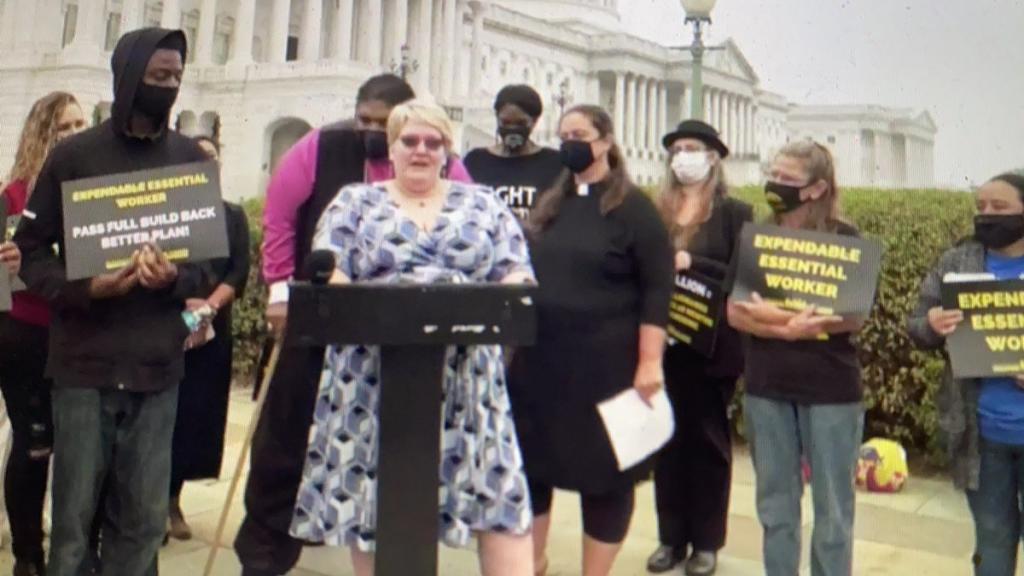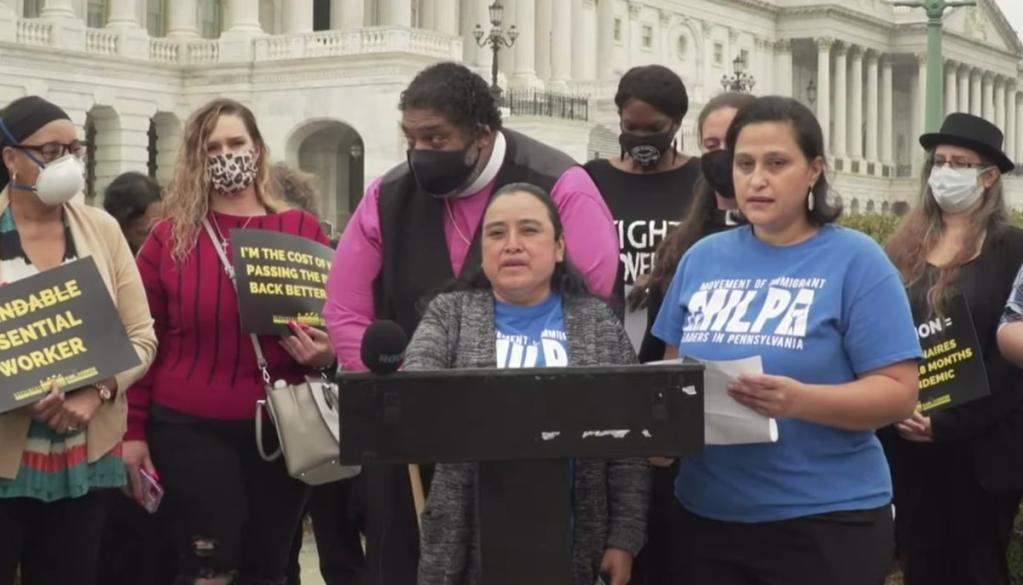
What is the cost of not passing Build Back Better?
Kaylen Marie Barker is a ninth-generation West Virginian whose ancestors moved to Appalachia to escape abject poverty. But despite having a master’s degree, Kaylen finds herself living in “generational poverty,” and spends time hunting for pennies in her couch cushions in order to put gas in her car.
Kaylen says her state desperately needs President Biden’s Build Back better plan, which would inject billions of dollars into West Virginia’s economy, lift children and families out of poverty, expand health care, and do so much more. And she says West Virginia in particular needs investments in both human infrastructure and physical infrastructure.

Kaylen Marie Barker, a ninth-generation West Virginian, says her state needs both human and physical infrastructure. (Photo by Clinton Wright.)
“I drive on roads that are falling over the mountains, bridges with exposed rebar and crumbling concrete where you can literally see the river below you,” she says. “People in my state don’t even have a clean glass of water to drink because our water is contaminated with radioactive material. Kids play in acid mine drainage that just pours into our creeks and rivers and no one bats an eye. This is all well known and it’s been going on for decades.”
Earlier this week, Kaylen and other low-wage workers from across the country came to Washington, D.C., where they delivered more than 100,000 signatures to Congress demanding passage of Build Back Better. They were joined by faith leaders, including Sister Richelle Friedman, who serves as Director of Public Policy for the Coalition on Human Needs.
Before the signature drop-off, the workers shared their stories at a news conference adjacent to the U.S. Capitol. Many workers and their allies emphasized that members of Congress need to focus less on how much the Build Back Better plan costs and more on the cost of inaction.
“In other words, it is not what is the cost of lifting from the bottom, but what is the cost of not lifting from the bottom,” said Rev. Dr. William J. Barber II, Co-Chair of the Poor People’s Campaign: A National Call for Moral Revival, which helped plan the event. “We have gotten stuck in a numbers argument instead of a people argument.”

As Dr. Rev. William J. Barber II listens in, Marcela Ramirez talks about her job as a produce packer in Philadelphia.
Marcela Ramirez is a mother and produce packer in Philadelphia who packs apples and other produce into children’s snack packages. “We are the ones who produce so much wealth in this nation, the ones who could not rest during the pandemic,” she said. “We are the ones who don’t have the right to get sick because we cannot miss work, those who run the risk of getting fired if we miss a day to be able to claim decent treatment during our movement.”
Katrina Corbell is a low-wage worker living in the Bronx. Fifteen years ago, she underwent two brain surgeries and her mom stayed at home to care for her – sacrificing her job to do so because her employer offered no family leave. Both Marcela and Katrina would benefit from the Build Back Better plan because – if it passes intact – it would require and fund a paid family and medical leave plan.
Joan Steede is a home care worker in Phoenix, Arizona. She routinely spends five hours caring for a veteran despite the fact that she is only paid for two hours, because that is all that the veteran can afford.
“Last week I took care of a woman with stage four pancreatic cancer,” Joan says. “She had no husband. She had no children…there are people in this country who are dying in their bed right now of cancer. Congressmen are going on vacation and leaving them in their bed to die.”
Joan said everyone should be interested in the issue of home care because most of us will need it one day. “We will all some day get old and need care,” she said. “And I will be there for you, and I will work for less than I’m worth because I care about other people.”
The current House version of the Build Back Better plan would help Joan as well as her clients by investing $190 billion in Medicaid-based Home and Community-Based Services. The money would go both toward offering workers benefits and living-wage salaries and expanding the number of people who are able to receive such care; currently waiting lists for home care in the U.S. number just under one million people, and some think that is an underestimate.
Advocates say that before COVID-19, 140 million Americans lived in poverty or were low income, and 700 people died a day from poverty. The money it would take to fully fund Build Back Better would be just 1.2 percent of the U.S. GDP over 10 years. Still, conservative Democrats want to significantly cut elements from the Build Back Better plan to reduce its cost.
“What we know and what this pandemic has laid bare is that women, people of color, poor communities, have been disproportionately impacted,” said the Rev. Dr. Liz Theoharis, Co-Chair of the Poor People’s Campaign. “By stripping the provisions that help women, help people of color, help poor communities, help essential workers recover, those who are standing against us, (Sen. Joe) Manchin, (Sen. Krysten) Sinema, all of folks who have the power in their hands to do something – they’re compromising the lives of essential workers and the poor. Their sending the message that people’s lives and their work don’t matter when we know that this is a lie.”
CHN’s Sister Richelle Friedman said the Build Back Better plan is a “once-in-a-generation opportunity” to invest in the very people most harmed by the pandemic – low-income individuals, families and communities, particularly Black and Brown communities who have suffered from chronic underinvestment and exclusion.
“In Catholic social justice teachings, the overarching Gospel mandate is to attend to people who are made poor,” Friedman said. “The Church holds strongly to the truth that the moral fabric of a nation is determined by how well it provides for the poor in its midst. Our nation must do better.”

